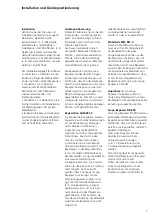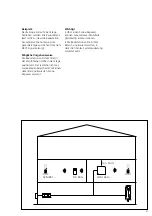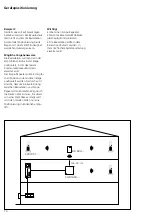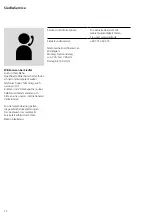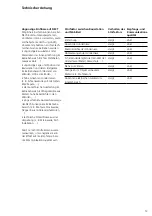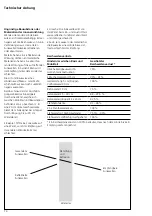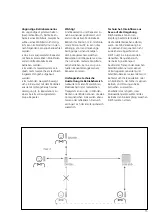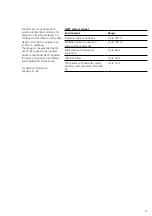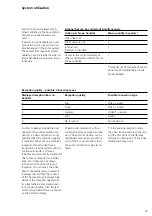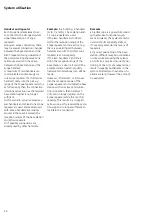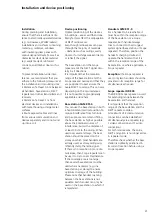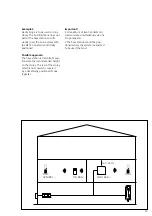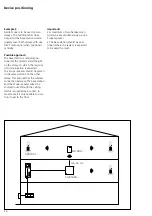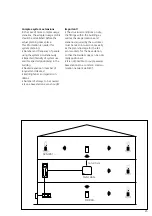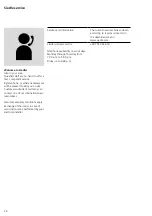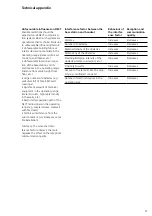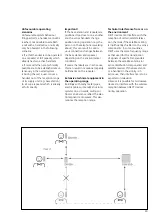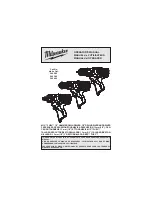
21
Installation and device positioning
Device positioning
Optimal positioning of the devices
in buildings – easier said than done.
Many factors affect the propagation
of DECT radio waves.
Even though radio waves can pass
through the majority of materials
– obstacles such as ceilings, walls,
doors or furnishings weaken (damp
or reflect) the signal.
The base station and the Scope
repeater emit the DECT signal circu
-
larly in all directions.
It is important that the reception
range of the base station and the
Scope repeater overlap and that they
are positioned to best ensure the
overall DECT coverage.
This can vary
depending on the circumstances.
It is not possible to give generally
applicable advice here.
Base station SGM 851-0
You can use the base station in both
a horizontal and vertical position.To
reduce interference from furniture
and people, we recommend fitting
the base station as high as possible
above the potential sources of
interference, but with a distance of
at least 30 cm to the ceiling.
When
used over several storeys, the base
station should be placed on the
storey on which most handsets are
actively used, as storey ceilings sig
-
nificantly damp the radio signal.
If there is no reception in more dis-
tant areas, then Scope repeaters can
be used to try to cover this distance.
If the coverage area is too large,
then several base stations must be
used where necessary (e.g. one
base station per storey) to ensure
optimum coverage of the building.
Please note that handset roaming
between the base stations is not
possible.
Each handset can only be
used on the base station to which it
is registered.
Handsets SZM 851-0
For a handset to be reachable, it
must be within the reception range
of the base station or a Scope
repeater.
Each handset always
tries to connect to the strongest
system signal (base station or Scope
repeater).
Therefore, position the
handset’s charging cradle and
operate the handset so that it is
within the reception range of the
base station or, where applicable, a
Scope repeater.
Exception:
If a Scope repeater is
used, only two handsets should be
provided in its reception range for
simultaneous active use.
Scope repeater DR 800
The DR 800 Scope repeater is used
for extending range between the
base station and handset.
It is important that the reception
range of the base station and the
DECT repeater overlap.
A maximum of 2 communication
connections can be established
simultaneously via a repeater (e.g.
1 video connection and 1 audio
connection).
For technical reasons, the entire
DECT encryption is no longer active
in repeater mode.
Therefore check whether the base
station is optimally positioned in
its current location before using a
Scope repeater.
Installation
During planning and installation,
ensure that there is sufficient dis
-
tance to electrically operated devices
(e.g. microwaves, WLAN routers),
installations and surfaces containing
metal (e.g. radiators, windows
with insulating glass panes with
vapour-deposited metal) as well as
obstacles made of dense material
(e.g. walls made of reinforced
concrete, solid timber doors or fur
-
niture).
To prevent installation-side inter-
ference, we recommend that you
adhere to the following measures at
the installation and mounting sites:
•
Distance of at least 0.5 m between
all handsets, base stations, DECT
repeaters and other transmitters and
receivers
•
Distance of at least 1 m from
electrical devices and installations
with metal housing or large metal
surfaces
•
Route exposed cables and lines
from various communication end
devices separately and do not wind
up into a coil

